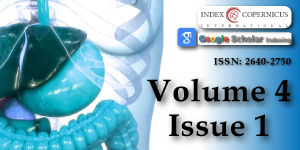Laparoscopic anterior transgastric cystogastrostomy for the treatment of pancreatic pseudocysts
Main Article Content
Abstract
Methods: We retrospectively analyzed data of patients with pancreatic pseudocysts treated by laparoscopic anterior transgastric cystogastrostomy from September 2010 to October 2014. All of the patients were controlled for the recurrence of pancreatic pseudocysts in February 2017.
Results: 14 patients with pancreatic pseudocysts were managed by laparoscopic anterior transgastric cysto-gastrostomy. Conversion was performed in only one patient (7%). There were no symptoms and signs of recurrence of pancreatic pseudocyst during on average 43.6 months follow up time.
Conclusion: Laparoscopic cystogastrostomy by using articulated linear endo-GIA stapler and versa-lifter is a safe and effective method for management of appropriate retro-gastric pancreatic pseudocysts.
Article Details
Copyright (c) 2020 Yetisir F, et al.

This work is licensed under a Creative Commons Attribution 4.0 International License.
Cannon JW, Callery MP, Vollmer CM. Diagnosis and management of pancreatic pseudocysts: what is the evidence? J Am Coll Surg. 2009; 3: 385-393. PubMed: https://www.ncbi.nlm.nih.gov/pubmed/19717045
Bradley EL. A clinically based classification system for acute pancreatitis. Summary of the International Symposium on Acute Pancreatitis. Arch Surg. 2009; 128: 586-590. PubMed: https://www.ncbi.nlm.nih.gov/pubmed/8489394
Sanfey H, Aguilar M, Jones RS. Pseudocysts of the pancreas, a review of 97 cases. Am Surg; 60: 661-668 4. Gumaste VV, Pitchumoni CS. (1996) Pancreatic pseudocyst. Gastroenterologist. 1994; 4: 33-43.
Boerma D, Obertop H, Gouma DJ. Pancreatic pseudocysts in chronic pancreatitis.Surgical or interventional drainage? Ann Ital Chir. 2000; 71: 43-50. PubMed: https://www.ncbi.nlm.nih.gov/pubmed/10829523
Maringhini A, Uomo G, Patti R, Rabitti P, Termini A, et al. Pseudocysts in acute nonalcoholic pancreatitis: incidence and natural history. Dig Dis Sci. 1999; 44: 1669-1673. PubMed: https://www.ncbi.nlm.nih.gov/pubmed/10492151
Kourtesis G, Wilson SE, Williams RA. The clinical significance of fluid collections in acute pancreatitis. Am Surg. 1990; 56: 796-799. PubMed: https://www.ncbi.nlm.nih.gov/pubmed/2268109
Aljarabah M, Ammori BJ. Laparoscopic and endoscopic approaches for drainage of pancreatic pseudocysts: a systematic review of published series. Surg Endosc. 2007; 21: 1936-1944. PubMed: https://www.ncbi.nlm.nih.gov/pubmed/17717626
Samir H, Peter VD. Pancreatic pseudocyst. World J Gastroenterol. 2009; 15: 38-47.
Palanivelu C, Senthilkumar K, Madhankumar MV. Management of pancreatic pseudocyst in the era of laparoscopic surgery--experience from a tertiary centre. Surg Endosc. 2007; 21: 2262-2267. PubMed: https://www.ncbi.nlm.nih.gov/pubmed/17516116
Mori T, Abe N, Sugiyama M, Atomi Y. Laparoscopic pancreatic surgery. J Hepatobiliary Pancreat Surg. 2005; 12: 451-455.
Frantzides CT, Ludwig KA, Redlich PN. Laparoscopic management of a pancreatic pseudocyst. J Laparoendosc Surg. 1994; 1: 55-59. PubMed: https://www.ncbi.nlm.nih.gov/pubmed/8173114
Hamza N, Ammori BJ. Laparoscopic drainage of pancreatic pseudocysts: a methodological approach. J Gastrointest Surg. 2010; 14: 148–155. PubMed: https://www.ncbi.nlm.nih.gov/pubmed/19789929
Mehta R, Suvarna D, Sadasivan S, John A, Raj V, et al. Natural course of asymptomatic pancreatic pseudocyst: a prospective study. Indian J Gastroenterol. 2004; 23: 140-142. PubMed: https://www.ncbi.nlm.nih.gov/pubmed/15213900
Yang CC, Shin JS, Liu YT, Yueh SK, Chou DA. Management of pancreatic pseudocysts by endoscopic cystogastrostomy. J Formos Med Assoc. 1999; 98: 283-286. PubMed: https://www.ncbi.nlm.nih.gov/pubmed/10389374
Ergül Z, Yetisir F, Hoca O, Baran İ. Massive Gastrointestinal Bleeding Due to Rupture of Splenic Artery Pseudoaneurysm Into the Pancreas Pseudocyst. Journal of Clinical Sciences & Doctor. 2005; 11: 269-272.
Haluszka O, Campbell A, Horvath K. Endoscopic managemnt of pancreatic in pseudocyst children. Gastrointest Endosc. 2002; 55: 128-131.
Libby ED, Taylor J, Mysh D, Schwaitzberg SD. Combined laparoendoscopiccystogastrostomy. Gastrointest Endosc.1999; 50: 416–419.
Yin WY. The role of surgery in pancreatic pseudocyst. Hepatogastroenterology. 2005; 52: 1266-1273. PubMed: https://www.ncbi.nlm.nih.gov/pubmed/16001676
Christos A, Ioannis P, Ioannis S, Demetrios D, Christos D. Review of management options for pancreatic pseudocysts. Transl Gastroenterol Hepatol. 2018; 3: 18. PubMed: https://www.ncbi.nlm.nih.gov/pubmed/29682625
Oida T, Mimatsu K, Kawasaki A. Long-term outcome of laparoscopic cystogastrostomy performed using a posterior ap- proach with a stapling device. Dig Surg. 2009; 26: 110-114.
Barragan B, Love L, Wachtel M, Griswold JA, Frezza EE. A comparison of anterior and posterior approaches for the surgical treatment of pancreatic pseudocyst using laparoscopic cystogastrostomy. J Laparoendosc Adv Surg Tech A. 2005; 15: 596-600. PubMed: https://www.ncbi.nlm.nih.gov/pubmed/16366865





